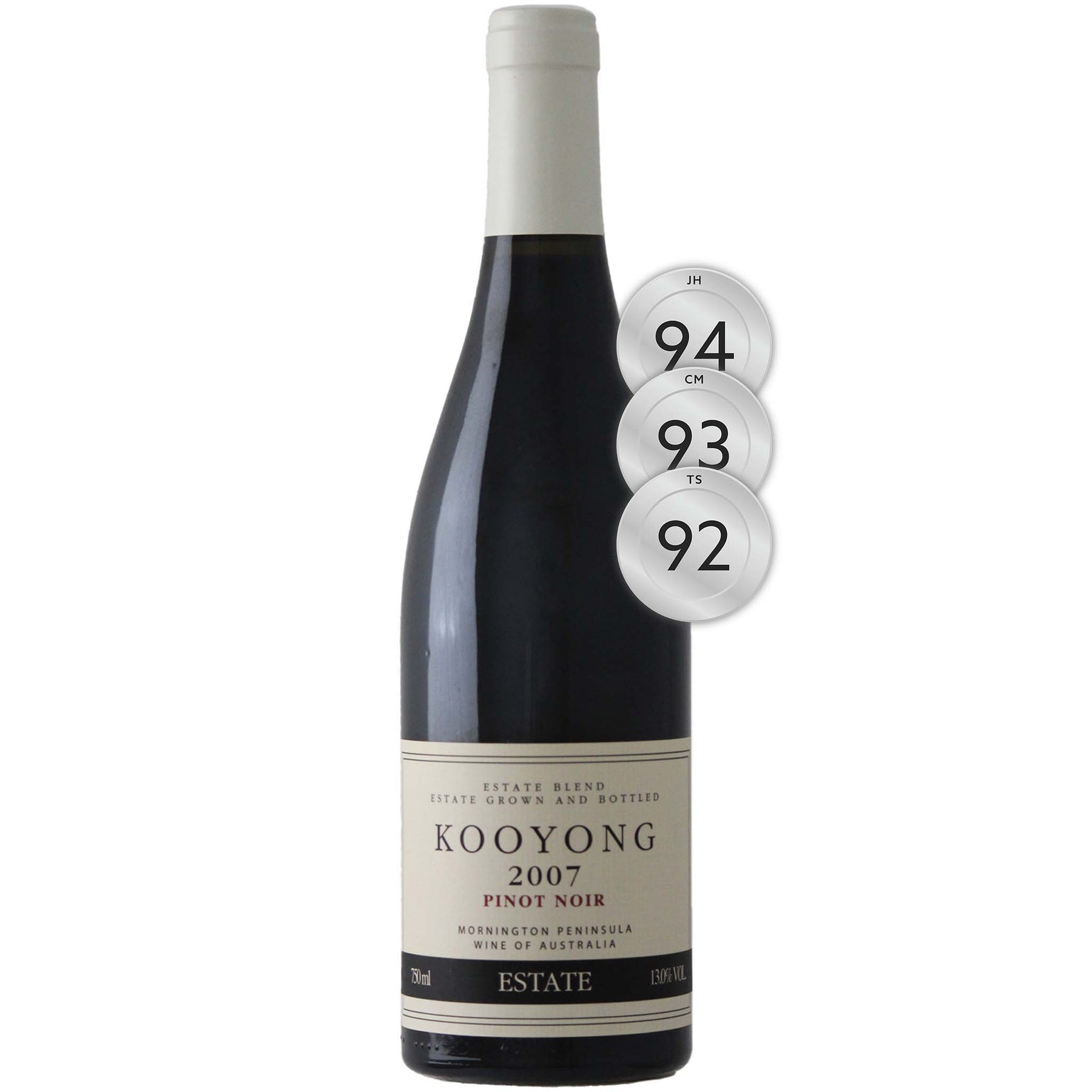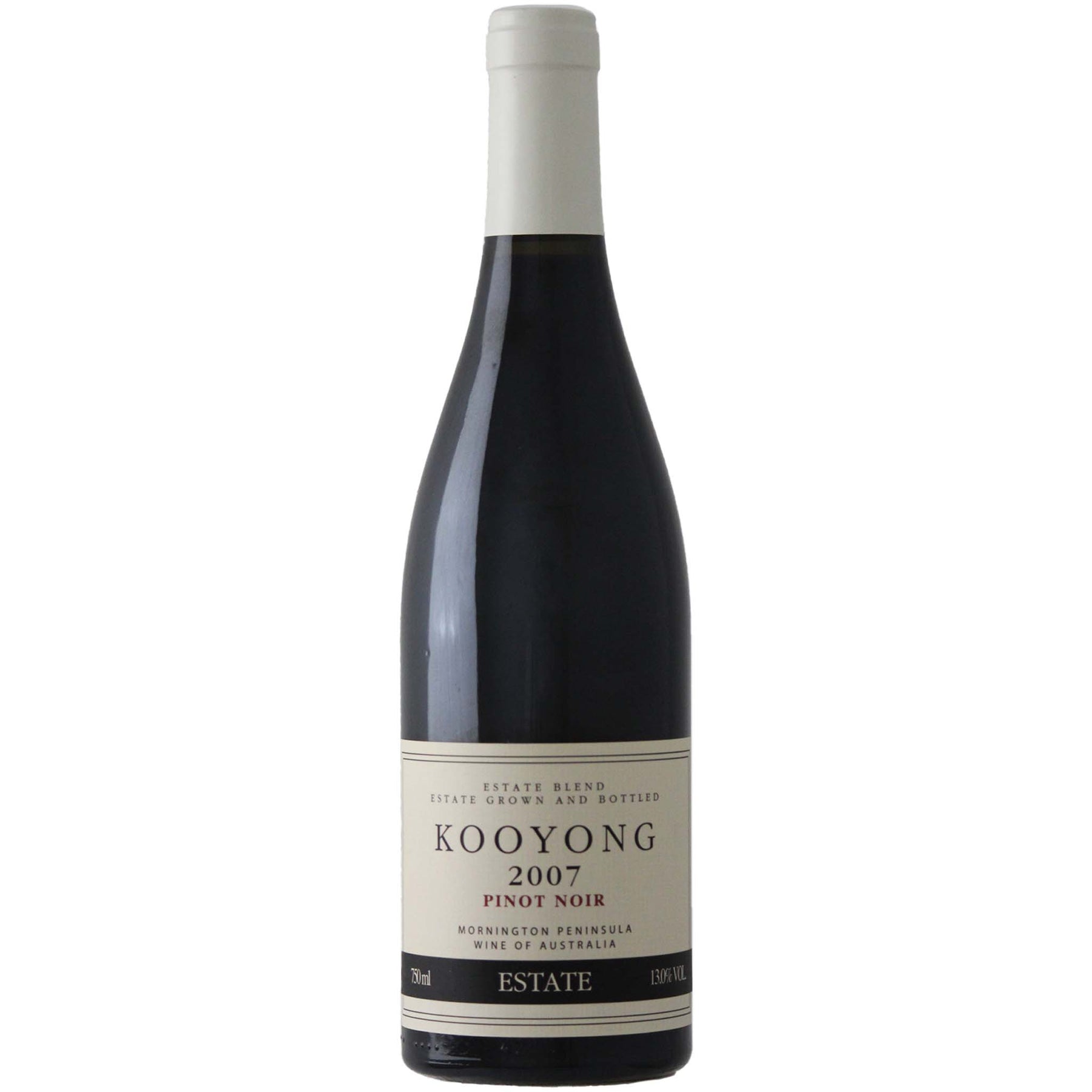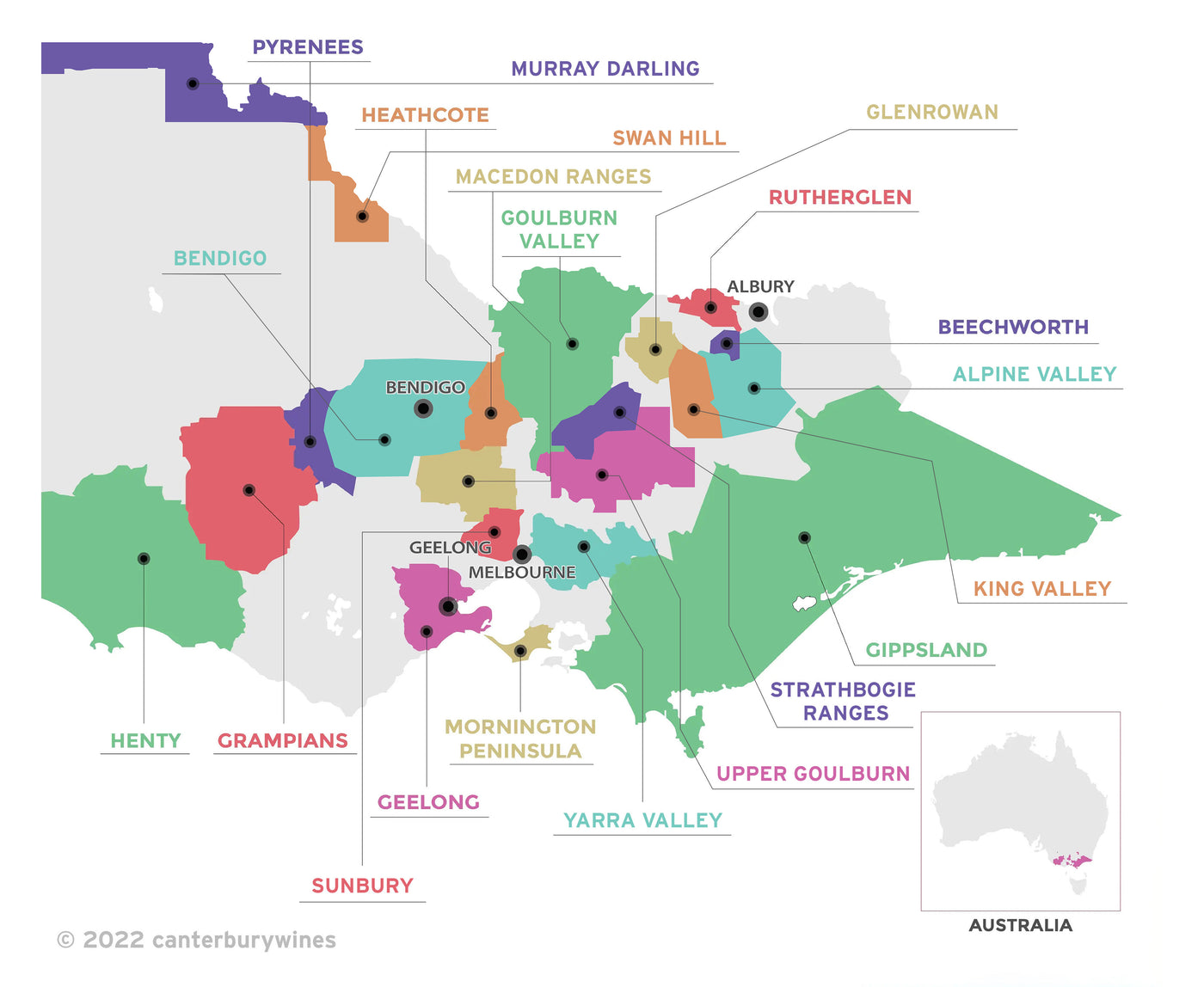

Kooyong Estate Pinot Noir 2007
Style: Red Wine
Closure: Cork
Kooyong Estate Pinot Noir 2007
Warehouse
34 Redland Drive
Vermont VIC 3133
Australia
Critic Score: 94
Alcohol: 13.0%
Size: 750 ml
Drink by: Now
Kooyong Estate, established in 1996, is a specialist Pinot Noir and Chardonnay producer located at Tuerong on the northern end of the Mornington Peninsula. The 40 ha vineyard is split into five blocks - Meres, Haven, Ferrous, Faultline and Farrago. The best selection of each block is reserved for the Kooyong single vineyard wines. The 2007 Estate Pinot Noir is crafted from grapes from the three Pinot Noir blocks; Meres, Haven and Ferrous.
"Cherry and plum fruit with a serving of Asian spices and complex ironstone nuances; the palate is fleshy on entry, but tightens up with fine-grained tannins and really vibrant acidity; a core of pure red fruit takes time to open on the palate." James Halliday
Expert reviews
"Cherry and plum fruit with a serving of Asian spices and complex ironstone nuances; the palate is fleshy on entry, but tightens up with fine-grained tannins and really vibrant acidity; a core of pure red fruit takes time to open on the palate. Cork. 13% alc." James Halliday, Halliday Wine Companion - 94 points
"The Kooyong wines are made by Sandro Mosele, who in a wine sense can hardly put a food wrong. Here is another gorgeous example. This is a pinot noir for control freaks – or that's the way it tastes. It's full of tense, chalky tannin and sappy, sour, tangy fruit flavour, so if you're after a hit of ripe sweetness then you should look away now. We love it, though. It's all about structure, length of flavour, sourness. Drink 2011-2016." Campbell Mattinson & Gary Walsh, The Big Red Wine Book – 93 points
"Always a winner, this year Kooyong's Estate Pinot has a little more vibrancy to its acidity and assertiveness to its tannin finish that will make it work well with duck and richer main course dishes. It has all the black cherry and bright re d berry fruit that we have come to love with this label." Tyson Stelzer, Wine Business Monthly (WBM) – 92 points
The vineyard blocks

The Kooyong vineyard is a 40-hectare site in the sub-region of Tuerong that lies at an altitude of 100-120 metres. The original Chardonnay and Pinot Noir vines were planted from 1996 to 1998 in five distinct blocks: Faultline, Farrago, Meres, Haven and Ferrous - refer to the vineyard map below.
Faultline Vineyard (Chardonnay)
The 10.0 hectare Faultline block, planted from 1996 to 1998, is the largest block at Kooyong. It is planted predominantly to Chardonnay in an area where the soils are characterised by a friable dark brown loamy clay.
Adjacent to the Farrago block to the West, the Faultline block is more gently sloping. The block is bounded by a geological fault that runs along the southwestern end, beyond which the soil becomes quite poorly drained. Before this fault, however, the soils are well drained and high in organic matter.
The Chardonnay from the Faultline block is rich and full, defined by a generosity of texture while still supported by Kooyong’s inherent minerality.
Farrago Vineyard (Chardonnay)
The 2.8 hectare Farrago block was planted in 1998 exclusively to Chardonnay. This small block is gently north-sloping with sediments ranging from those higher in sand to those higher in clay.
The best fruit within the block comes from the zone higher in clay where the soil has a mottled appearance due to high sandstone pebble content, hence the block’s name Farrago.
The Chardonnay from the Farrago block is defined by a precise linear character with strong silicaceous minerality. At its best, this is the premier white wine with the greatest ageing potential.
Meres Vineyard (Pinot Noir)
The 6.2 hectare Meres block was planted from 1996 to 1997. The block is planted entirely to Pinot Noir except for a tiny 0.1 hectare annexe planted to Pinot Gris. Located along the eastern boundary of Kooyong, the name Meres alludes to water bodies – the dams that flank the block on all sides.
This gently sloping block is the most exposed of all our Pinot Noir plantings, leading to low vigour and low yields. The combination of the soils, a less loamy topsoil and more clay subsoil than the other blocks, and low vigour produces highly aromatic and perfumed red-fruited Pinot Noir with a structure that, as the vines age, is becoming more robust.
Haven Vineyard (Pinot Noir)
The 6.9 hectare Haven block was planted in 1996 exclusively to Pinot Noir. The block is the most sheltered of the vineyard blocks. It is a relatively level site surrounded by thick tree belts which protect it from strong winds. The soils are classed as a duplex loam over clay, have a relatively higher percentage of loam and a moderate amount of sandstone pebbles interspersed through the soil profile.
The lack of exposure to strong winds allows the vines to keep a rich green canopy until comparatively late in the ripening period and the resulting Haven Pinot Noir possesses fruit in the more purplish spectrum with a certain richness and lushness yet a firm underlying tannic structure. Regal and poised, Haven shows excellent capacity for ageing.
Ferrous Vineyard (Pinot Noir)
The 5.1 hectare Ferrous block was planted in 1997 exclusively to Pinot Noir. The block lies to the East of and adjacent to the Haven block. It is a more sloping block than Haven, therefore more rapidly draining, and is also much less protected from winds – a little like Meres.
These vines naturally produce low yields due to a combination of unique orientation, free drainage and a lack of protection from the elements. Together with this, the soil of the Ferrous block has a far greater prevalence of ironstone pebbles than any other part of the vineyard and delivers wine with great concentration and savoury tannic presence.

Kooyong Estate Vineyard Map
About the winery

Kooyong Estate is a specialist Pinot Noir and Chardonnay producer located at Tuerong on the northern end of the Mornington Peninsula. The vineyard, in one of Australia's foremost cool climate maritime wine growing regions, was established by property developer Chris Aylward and his wife Gail in 1996.
The Aylwards purchased a weekender at nearby Shoreham that happened to include one hectare of Chardonnay vines. They employed a young genetics honours graduate, Sandro Mosele, to look after the vineyard. Mosele realised that the Red Hill vineyard was not ideal for viticulture, so he set out to find a warmer site capable of producing vines of low vigour to keep yields naturally low. This led to the Aylwards purchasing a 93 hectare property in Tuerong that had gentle north-facing slopes, moderate rainfall and relatively free-draining soils.
The 33 ha Kooyong vineyard was planted on the property between 1996 and 1998. Aside from tiny pockets of pinot gris and shiraz, the vineyard was exclusively devoted to the Burgundian varieties, Pinot Noir and Chardonnay. Only 4ha of the original vineyard remains unchanged, the other vines have been grafted, moved onto a different trellising system or discarded. The early plantings were largely established with Scott Henry and Geneva Double Curtain GDC trellises, however, Mosele changed to vertical shoot positioning, the canopy design most suited to the region. As Mosele said in 2002, "We made mistakes, but we fixed our mistakes".
Today, the vineyard has 21 ha of Pinot Noir, 11 ha of Chardonnay and a small plot of Pinot Gris. The vineyard is split into five individual blocks with a variety of clones (8 Pinot and 10 Chardonnay clones) and very different soils, and everything is done to enhance and express the natural characteristics of each block. The vineyard comprises three Pinot Noir blocks (Meres, Haven and Ferrous) and two Chardonnay blocks (Faultline and Farrago). The best selection of each block is reserved for the Kooyong single vineyard wines.
In 1998, plans for a large and modern winery were devised and construction began. State-of-the-art equipment was installed to give the winemaking team the best possible opportunity to produce top quality wines. Aiming high was always Kooyong's goal. In 2001, Kooyong released their first wines commercially with the 1999 vintage. Only a third of the vintage was sold under the Kooyong label to preserve quality and the annual production since then had been rigorously capped at around 10,000 cases in total. Sandro Moselle's wizardry with Pinot Noir and Chardonnay was behind Kooyong's early success and recognition as one of the Mornington Peninsula's top producers.
The Aylwards sold Kooyong to current owners Giorgio and Dianne Gjergja in 2004. The Gjergjas had purchased Port Phillip Estate 4 years earlier in 2000. The Gjergjas were rightly more than content with the quality and style of the wines; the main change was the move of Kooyong's cellar door and winery in 2009 to the grand and imposing multi-million complex at Port Phillip Estate.
Sandro Moselle stayed on as Chief Winemaker until July 2015, when he left to pursue other opportunities. He was replaced by Glen Hayley who had worked with Mosele for the previous six years. He continued and enhanced Mosele's work, with an enduring focus on exploring the nuances of sites within the vineyards. Glen stayed on at Kooyong and Port Phillip until 2023 when he ended a 13-year association (the last seven as Chief Winemaker) to pursue other interests overseas. Tim Perrin, who had worked as senior winemaker with Oakridge Wines in the Yarra Valley for the previous seven years, replaced Glen.

Victoria
Victoria is home to more than 800 wineries across 21 wine regions. The regions are Alpine Valley, Beechworth, Bendigo, Geelong, Gippsland, Glenrowan, Goulburn Valley, Grampians, Heathcote, Henty, King Valley, Macedon Ranges, Mornington Peninsula, Murray Darling, Pyrenees, Rutherglen, Strathbogie Ranges, Sunbury, Swan Hill, Upper Goulburn and Yarra Valley.
Victoria's first vines were planted at Yering in the Yarra Valley in 1838. By 1868 over 3,000 acres had been planted in Victoria, establishing Victoria as the premier wine State of the day. Today, the original vineyards planted at Best's Wines are among the oldest and rarest pre-phylloxera plantings in the world.
Victoria's climate varies from hot and dry in the north to cool in the south and each wine region specialises in different varietals. For example, Rutherglen in the north is famous for its opulent Muscats and Topaque and bold reds, while the many cooler climate regions near Melbourne produce world class Chardonnay and pinot Noir. Victoria is truly a wine lover's playground.
